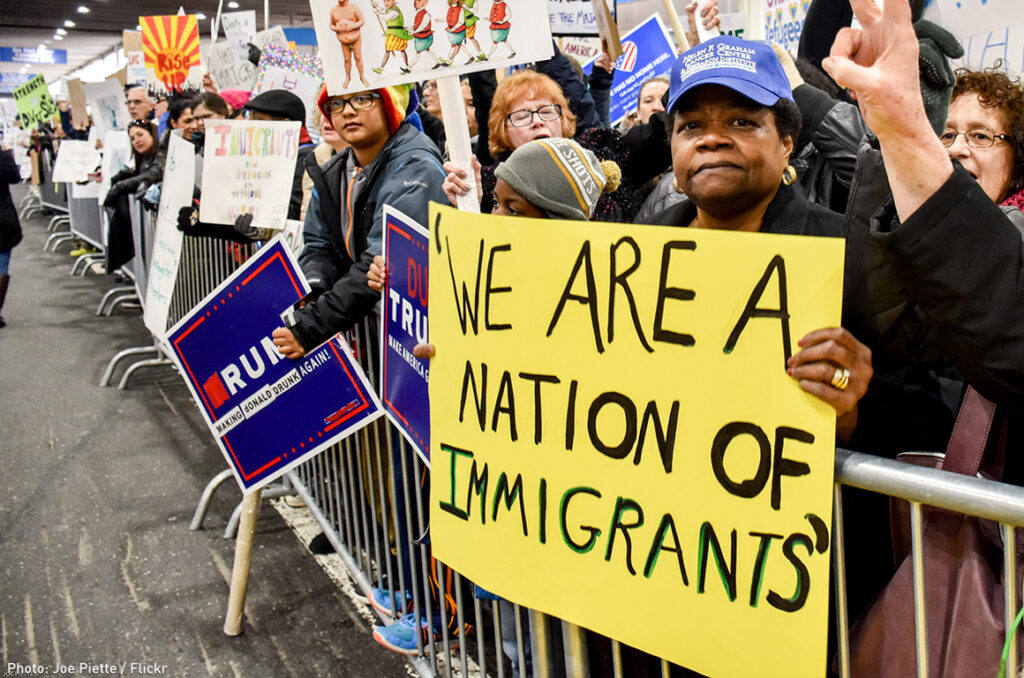How misinformation and insecurity about immigration have fueled harsher border enforcement

(Archive) Credit: Joe Piette/Flickr. Source: ACLU
Recent years have seen increasingly harsh immigration policies, especially for irregular migrants entering at the US-Mexico border. Lauro Accioly Filho writes that misinformation about the effects of immigration to the US, such as crime rates, has been combined with the framing of immigration as a national security threat. Working together, these two factors have resulted in US border policies that are more harmful for irregular migrants.
By Lauro Accioly Filho, for USAPP/LSE* [Republicação] [Latin America] [América Latina] [Migração]
In the United States, public perceptions of Latin American immigrants, often reflect deep-rooted and historical traits of xenophobia. A 2015 Pew Research Center study revealed that a large portion of Americans believed the presence of immigrants had worsened the country’s economic situation and led to increased crime rates. Studies suggest that those who hold such views are more likely to support the construction of a wall along the US-Mexico border – a highly costly project – over other immigration-related policies. This negative perception is made worse in the current climate of misinformation, which contributes to the spread of misconceptions about immigration across the United States.
Misinformation about immigration and crime
In this context, the construction of the border wall was one of Donald Trump’s flagship political promises in his first presidential term, becoming the pillar of his broader migration agenda during his presidency. Furthermore, Trump exerted significant influence over the political agenda via Twitter (now X), spreading misinformation and distortions on immigration and other topics. Also, research shows that many of the negative perceptions of immigrants, regardless of legal status, are highly distorted. When it comes to crime in the United States, for instance, there is growing evidence that immigrants – both documented and undocumented – are less likely to commit crimes than native-born citizens. This phenomenon is borne out in data indicating that, since 2012, most crimes have been committed by native-born Americans. Nationally, the crime rate among undocumented immigrants has historically been low. Since 1980, immigrants have had lower incarceration rates than native citizens – a pattern sustained for over 150 years. Nonetheless, a substantial number of Americans still believe that immigration increases criminality.
Given this, is misinformation the only factor shaping these negative perceptions? In my recent research, I found that although it plays an important role, it is not the sole element at play. But, a concept widely discussed in International Relations – securitization – has gained relevance in this debate. This concept explores how certain issues are strategically framed as matters of national security or threats, thus legitimizing the adoption of emergency and exceptional measures. Some scholars argue that this process results in a social engineering of insecurity, where certain topics are repeatedly framed as security problems to justify increasingly restrictive policies – which often creates more issues than it solves.
Prevention through deterrence at the US-Mexico border
In this way, securitization has become a recurring strategy in US politics, particularly after the 11 September 2001 attacks. This process involves framing immigration as a threat to national security, thus legitimizing restrictive policies and emergency measures.
This scenario directly applies to the issue of the US-Mexico border. Since Bill Clinton’s administration, the US government has adopted the strategy of prevention through deterrence, which strengthened border control through heavy investment in surveillance and enforcement infrastructure, pushing migrants towards more perilous crossing routes – a policy that has contributed to increased migrant deaths. As migrants are forced to seek out more dangerous routes, their lives are placed at greater risk. This reflects a deterrence-base strategy – in other words, the intention is to discourage irregular migration, rather than to completely prevent these groups from entering the country. This model was further amplified under George W. Bush and became a central pillar of Donald Trump’s agenda.
 (Archive) A U.S. Border Patrol vehicle sits along the border barrier separating San Diego and Tijuana Mexico watching for illegal crossings in March 2016 (Credit: Donna Burton/Flickr)
(Archive) A U.S. Border Patrol vehicle sits along the border barrier separating San Diego and Tijuana Mexico watching for illegal crossings in March 2016 (Credit: Donna Burton/Flickr)
Misinformation helps push harsher border policies
So, the US-Mexico border wall – one of Trump’s main campaign 2016 promises – exemplifies how securitization and misinformation go hand in hand in shaping immigration policy. Particularly among groups who believe that immigration worsens crime and harms the economy, there is a tendency to support border-closing policies, such as the wall. Moreover, Trump played a major role in setting the political agenda through social media, spreading false and distorted information about immigration. His statements, magnified by social media coverage, helped to strengthen the belief that immigrants pose a threat to the country. Thus, his rhetoric, combined with the dissemination of misleading data, not only distorted the reality of immigration in the United States but also resulted in policies that increased precarity for migrants and heightened violence along the border.
The social engineering of insecurity
The broader context of insecurity is also reinforced by both real and manufactured crises. Times of economic instability, terrorist attacks and outbreaks of violence are frequently exploited for political gain, associating immigration with imminent threats. This “social engineering of insecurity” legitimizes tougher border policies and reinforces a cycle of exclusion: the more immigrants are portrayed as threats; the more justification arises for restricting their rights and intensifying control measures.
Beyond the political and social consequences, the securitization of immigration has direct effects on migrants’ lives, rendering their conditions in the US increasingly precarious. Border militarization, for instance, does not prevent irregular immigration — it simply makes it more dangerous. The criminalization of migration leads to family separations, mass deportations, and the marginalization of entire communities.
Thus, it becomes clear that misinformation is not the sole driver behind the negative perception of immigrants. The broader context of insecurity — both real and fabricated — plays a central role in constructing immigration as a threat. This process fuels restrictive policies, deepens migrant marginalization, and sustains a distorted view of the reality of migration in the United States. ![]()
* Lauro Accioly Filho is a PhD candidate at Interinstitutional Graduate Program in International Relations – San Tiago Dantas and Visiting Scholar at American University.
** This article was originally published on the blog United States Politics and Policy (USAPP/LSE), on April 29th, 2025, and republished here with the author’s permission. This content does not necessarily reflect the opinion of OPEU, or INCT-INEU.
*** About OPEU, or to contribute articles, contact editor Tatiana Teixeira. E-mail: tatianat19@hotmail.com. About our Newsletters, for press service, or other matters, contact Tatiana Carlotti. E-mail: tcarlotti@gmail.com.
Subscribe to our Newsletter and receive OPEU content by email.
Follow OPEU on Instagram, Twitter, Linkedin and Facebook and follow our daily posts.
Comment, share, send suggestions, be part of our community.
We are a unique Brazilian research observatory on the United States,
with weekly, free, non-profit content.





















